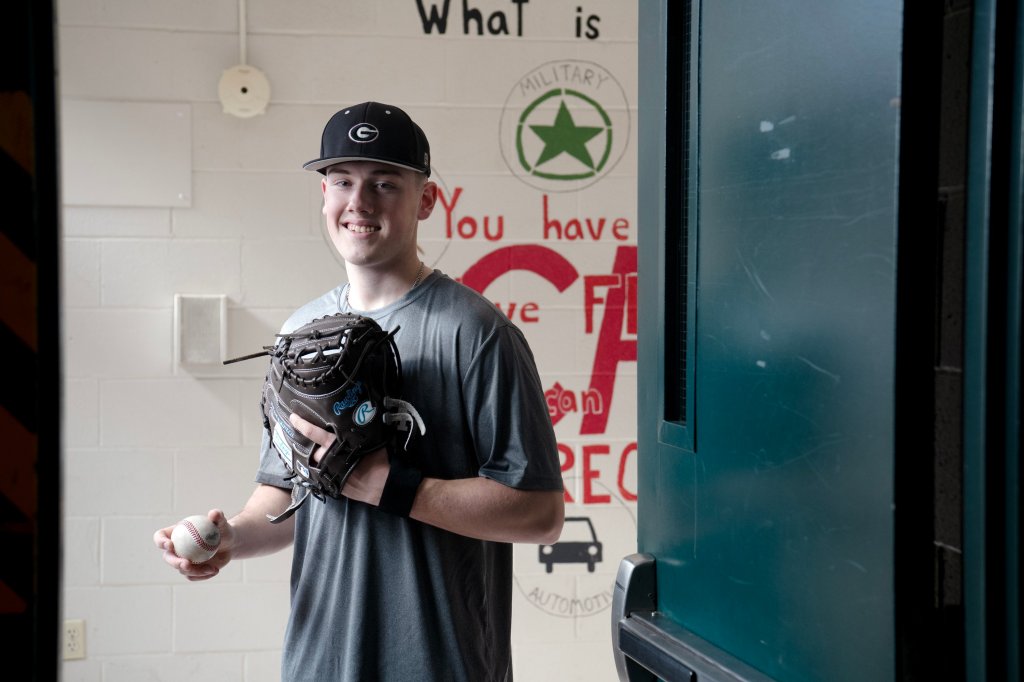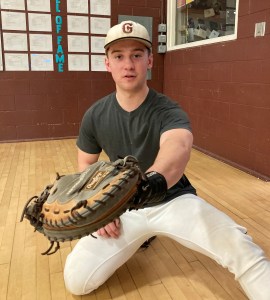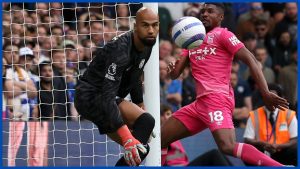Apr. 15—More Maine high school baseball pitchers are joining prominent NCAA Division I college programs, thanks to the advent of high-level club baseball, indoor training facilities, and an abundance of good coaching options.
Starting with current Kansas City Royals farmhand Hunter Owen and Noah Lewis at South Portland going to Vanderbilt and Maine in 2021, through active Division I pitchers Brady Afthim and Drew Smith (UConn), Cody Bowker (Georgetown/Vanderbilt) and Zach Johnston (Wake Forest), to the current crop headlined by Gorham’s Wyatt Nadeau, many high school pitchers in Maine have become hard throwers who also have sharp breaking balls.
That also means Maine’s high school catchers have had to work harder to improve.
“We know how to train kids to throw harder. Catching has to keep up because it’s a premium position. You can’t win without it,” said Marc Halstead, coach of defending Class B champion Yarmouth.
Nadeau, a 6-foot-6 right-handed pitcher who has committed to Vanderbilt, is now throwing his fastball in the mid-90s, topping out at 97 mph, he says. He also has a slider, curve and changeup to keep hitters uncomfortable. And he has a senior catcher, Mason Finck, whom he trusts.
“I mean, the catcher helps me out so much. Mason’s amazing,” Nadeau said. “We’ve been the pitcher-catcher battery since we were 8, 9 years old. He’s always been able to catch me. That’s lucky to have somebody like that in Gorham, because I’ve gone other places and it’s been a struggle with catchers.”
Finck, who has been all-conference as a third baseman and a utility player during his first three high school seasons, is primarily a catcher. In the offseason while playing for the Maine Lightning club program, he’s caught 2024 SMAA Pitcher of the Year Erik Swenson of Scarborough and Isaac Jensen of Kennebunk, as well as his brother, Hunter, a sophomore who is already throwing in the 90s.
“I spent a lot of time this winter catching off the pitching machine with it cranked up,” Finck said. “It trains your eyes and your reaction time.”
Also in Class A South, Thornton Academy junior Brayden Duane returns after being named second-team all-conference. Brady Stone is Kennebunk’s veteran catcher, and he’ll be handling Jensen’s high-80s fastball. South Portland coach Mike Owens is glad his deep staff has second-year starter Cam Barrett behind the plate. Sanford coach Kyle Bernier feels good about entrusting his varsity mound newcomers to catcher Matthew Hebert.
The Western Maine Conference has a wealth of catching talent, led by two-time first-team pick Wyatt Soucie, a senior at Greely. Greely’s top pitcher, 6-foot-3 Keeler Vogt, is touching 90 mph with his fastball, and Soucie said, “He has like five different pitches that are just disgusting. I could not hit off him, even though I know all his pitches.”
When Soucie was a freshman, he caught Johnston in practices and consecutive no-hitters thrown by Ryan Kolben, who was Greely’s starting catcher and now catches at UMass.
“I had to kind of jump into it my freshman year, so it made me a better player,” Soucie said. “To catch at that level, you almost have to … try to get up to that level.”
Wells junior Cal Moody (second-team WMC), York senior Bradley Carr, Cape Elizabeth senior Jimmy Hollowell (one error in two seasons), Freeport sophomore Jacob Cass and Gray-New Gloucester senior Kaiden Chase (one passed ball in 2024) are other top performers.
Coaches and teammates have always appreciated a catcher’s total value — leadership, defense, smarts, and then hitting.
“I definitely feel like it’s important. I don’t want to give myself too much credit, either,” Soucie said. “But I would say, in general, in baseball it’s a very underrated position. Even something as simple as every pitch, you’re worried about how you’re framing that pitch.”
Defense is still paramount. First comes the simple act of catching a pitch. Then there’s the ability to block a misfired pitch in the dirt. When catchers can be counted on to stop a ball in the dirt, pitchers are more confident in throwing their best breaking ball. And runners have to be sure before they take off for the next base.
York coach Nick Hanlon said of his catcher, “Bradley Carr gives (pitchers) a ton of confidence in his blocking game and ability to control the run game of the opposition.”
Catchers have also refined the art of framing the location of the pitch, sometimes called stealing a strike. There are multiple methods, often used simultaneously, to make a slightly low, wide or high pitch look to an umpire like a strike that crossed the 17-inch wide plate.
“The way you actually catch the ball is important,” Finck said. “You want to start from down and move up.” That’s why catchers are much more likely to go to a one-knee crouch, because they can get their glove lower and be moving up into the strike zone, with their glove in an upright position.
“And I’ll angle my body in toward the plate when I set up outside or inside to make it appear more like a strike,” Finck added.
Soucie is good at framing, Vogt said, and also adept at the related act of setting a target.
“Wyatt has great posture and stands tall and makes himself look like a strike zone to me, and then that glove is right there in the middle and makes it easy for me to wrap my head around and throw strikes,” Vogt said.
Vogt agrees that as pitchers get better, so do the catchers — and both are helping each other improve.
“I imagine they correlate very well. I mean, you look at Gorham, great catchers, great pitchers. All the best schools have the best pitchers and the best catchers,” Vogt said.
Copy the Story Link
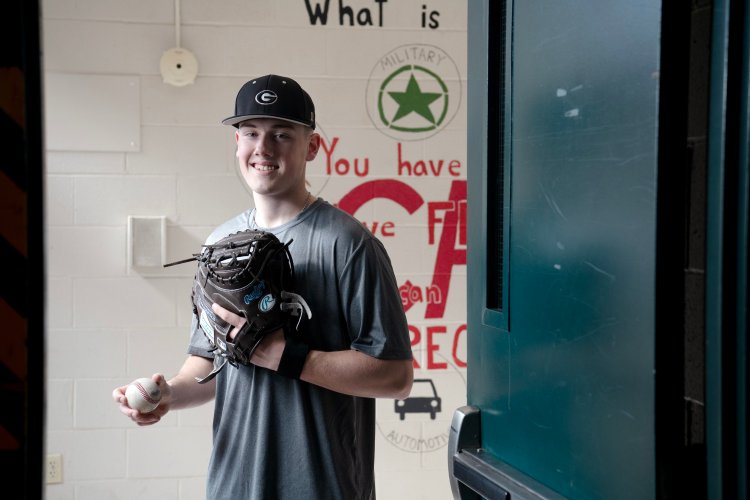
Gorham catcher Mason Finck has the challenge of catching pitcher Wyatt Nadeau, who throws in the mid-90s and has multiple off-speed pitches. Daryn Slover/Portland Press Herald
More Maine high school baseball pitchers are joining prominent NCAA Division I college programs, thanks to the advent of high-level club baseball, indoor training facilities, and an abundance of good coaching options.
Starting with current Kansas City Royals farmhand Hunter Owen and Noah Lewis at South Portland going to Vanderbilt and Maine in 2021, through active Division I pitchers Brady Afthim and Drew Smith (UConn), Cody Bowker (Georgetown/Vanderbilt) and Zach Johnston (Wake Forest), to the current crop headlined by Gorham’s Wyatt Nadeau, many high school pitchers in Maine have become hard throwers who also have sharp breaking balls.
That also means Maine’s high school catchers have had to work harder to improve.
“We know how to train kids to throw harder. Catching has to keep up because it’s a premium position. You can’t win without it,” said Marc Halstead, coach of defending Class B champion Yarmouth.
Nadeau, a 6-foot-6 right-handed pitcher who has committed to Vanderbilt, is now throwing his fastball in the mid-90s, topping out at 97 mph, he says. He also has a slider, curve and changeup to keep hitters uncomfortable. And he has a senior catcher, Mason Finck, whom he trusts.
“I mean, the catcher helps me out so much. Mason’s amazing,” Nadeau said. “We’ve been the pitcher-catcher battery since we were 8, 9 years old. He’s always been able to catch me. That’s lucky to have somebody like that in Gorham, because I’ve gone other places and it’s been a struggle with catchers.”
Finck, who has been all-conference as a third baseman and a utility player during his first three high school seasons, is primarily a catcher. In the offseason while playing for the Maine Lightning club program, he’s caught 2024 SMAA Pitcher of the Year Erik Swenson of Scarborough and Isaac Jensen of Kennebunk, as well as his brother, Hunter, a sophomore who is already throwing in the 90s.
“I spent a lot of time this winter catching off the pitching machine with it cranked up,” Finck said. “It trains your eyes and your reaction time.”

Kennebunk’s Brady Stone has to handle pitches from Isaac Jensen, who throws in the mid-80s. Gregory Rec/Portland Press Herald
Also in Class A South, Thornton Academy junior Brayden Duane returns after being named second-team all-conference. Brady Stone is Kennebunk’s veteran catcher, and he’ll be handling Jensen’s high-80s fastball. South Portland coach Mike Owens is glad his deep staff has second-year starter Cam Barrett behind the plate. Sanford coach Kyle Bernier feels good about entrusting his varsity mound newcomers to catcher Matthew Hebert.
The Western Maine Conference has a wealth of catching talent, led by two-time first-team pick Wyatt Soucie, a senior at Greely. Greely’s top pitcher, 6-foot-3 Keeler Vogt, is touching 90 mph with his fastball, and Soucie said, “He has like five different pitches that are just disgusting. I could not hit off him, even though I know all his pitches.”
When Soucie was a freshman, he caught Johnston in practices and consecutive no-hitters thrown by Ryan Kolben, who was Greely’s starting catcher and now catches at UMass.
“I had to kind of jump into it my freshman year, so it made me a better player,” Soucie said. “To catch at that level, you almost have to … try to get up to that level.”
Wells junior Cal Moody (second-team WMC), York senior Bradley Carr, Cape Elizabeth senior Jimmy Hollowell (one error in two seasons), Freeport sophomore Jacob Cass and Gray-New Gloucester senior Kaiden Chase (one passed ball in 2024) are other top performers.
Coaches and teammates have always appreciated a catcher’s total value — leadership, defense, smarts, and then hitting.
“I definitely feel like it’s important. I don’t want to give myself too much credit, either,” Soucie said. “But I would say, in general, in baseball it’s a very underrated position. Even something as simple as every pitch, you’re worried about how you’re framing that pitch.”
Defense is still paramount. First comes the simple act of catching a pitch. Then there’s the ability to block a misfired pitch in the dirt. When catchers can be counted on to stop a ball in the dirt, pitchers are more confident in throwing their best breaking ball. And runners have to be sure before they take off for the next base.
York coach Nick Hanlon said of his catcher, “Bradley Carr gives (pitchers) a ton of confidence in his blocking game and ability to control the run game of the opposition.”
Catchers have also refined the art of framing the location of the pitch, sometimes called stealing a strike. There are multiple methods, often used simultaneously, to make a slightly low, wide or high pitch look to an umpire like a strike that crossed the 17-inch wide plate.
“The way you actually catch the ball is important,” Finck said. “You want to start from down and move up.” That’s why catchers are much more likely to go to a one-knee crouch, because they can get their glove lower and be moving up into the strike zone, with their glove in an upright position.
“And I’ll angle my body in toward the plate when I set up outside or inside to make it appear more like a strike,” Finck added.
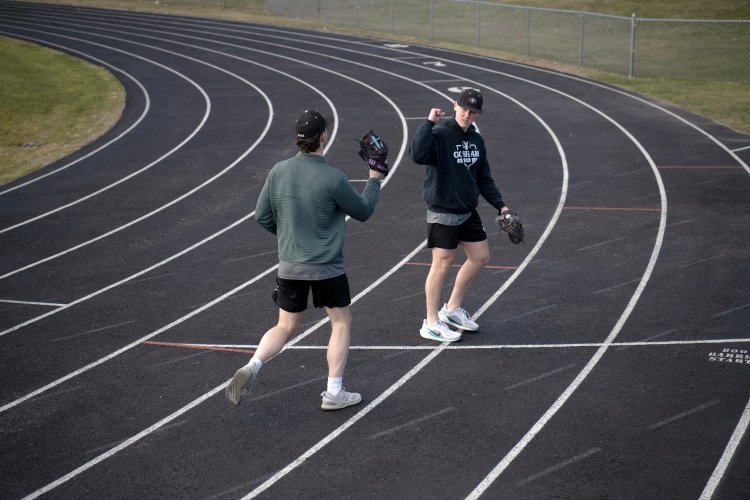
Gorham catcher Mason Finck, right, gives pitcher Jack Karlonas a fist bump after the teammates warmed up during practice last week. Daryn Slover/Portland Press Herald
Soucie is good at framing, Vogt said, and also adept at the related act of setting a target.
“Wyatt has great posture and stands tall and makes himself look like a strike zone to me, and then that glove is right there in the middle and makes it easy for me to wrap my head around and throw strikes,” Vogt said.
Vogt agrees that as pitchers get better, so do the catchers — and both are helping each other improve.
“I imagine they correlate very well. I mean, you look at Gorham, great catchers, great pitchers. All the best schools have the best pitchers and the best catchers,” Vogt said.
Related Headlines
